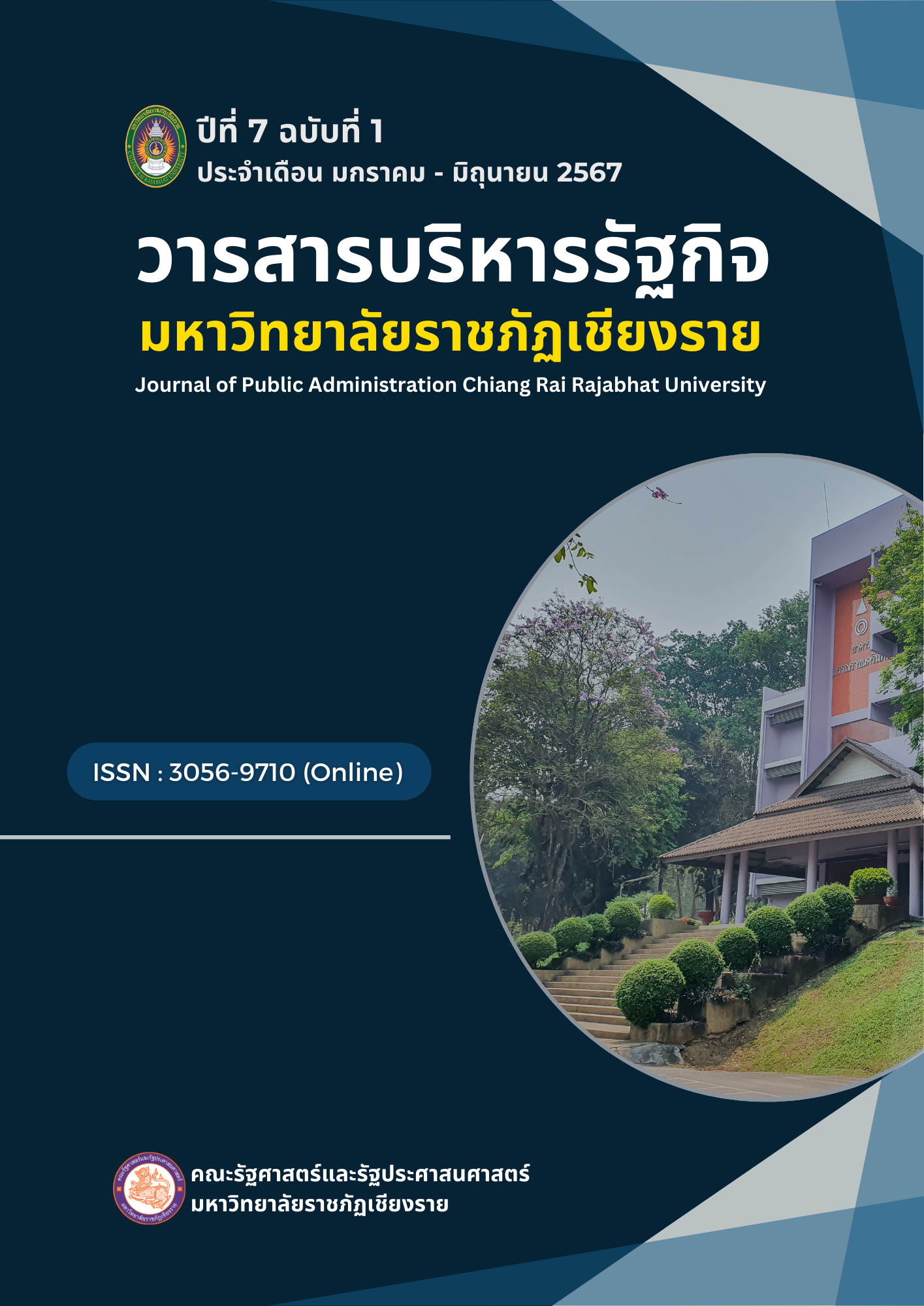Development of Integrated Risk Management Concepts in Organizations
Main Article Content
Abstract
This article focuses on studying risk management models to be analyzed, developed, improved, and applied within various organizations. The study found that there should be a process for developing risk management within the organization regularly to increase organizational management potential under multiple processes that lead to continuous dynamic risk acceptance. The consideration of human resource management guidelines must also be taken into account. This is because the internal resources of each organization are limited. When considering personnel, budget, materials, equipment, machinery, and management methods, for this reason, develop human resources by enhancing knowledge, improving skills and expertise in specific areas, training to adjust, attitudes towards work, and focusing on improving employee behavior to create enthusiasm. Therefore, it is a process of conceptual integration. To concretely transform into a learning organization, risk management needs to develop a process model combined with various theories in a comprehensive manner, which will create sustainable integrated risk management in the organization.
Article Details
References
กิตติพันธ์ คงสวัสดิ์เกียรติ. (2554). การจัดการความเสี่ยงและตราสารอนุพันธ์เบื้องต้น. กรุงเทพมหานคร: เพียร์สัน เอ็ดดูเคชั่น อินโดไชน่า จำกัด.
กิตติพันธ์ คงสวัสดิ์เกียรติ, ณัฎฐ์ชัย สิริธนธานี และภัคสิริกาญจน์ สิริธนธานี. (2557). การจัดการความเสี่ยงและตราสารอนุพันธ์. กรุงเทพมหานคร: แม็คกรอ-ฮิล.
กัญชพร ศรมณี. (2559). การจัดการทรัพยากรมนุษย์ท่ามกลางกระแสโลกาภิวัตน์. วารสารปัญญาภิวัฒน์, 8(1), 275-287.
จุฑามน สิทธิผลวนิชกุล. (2561). แนวทางการบริหารความเสี่ยงองค์กร COSO Enterprise Risk Management 2017. วารสารวิชาชีพบัญชี, 14(42), 111-124.
จันทนา สาขากร. (2550). COSO: ERM กับงานตรวจสอบภายใน. วารสารวิชาชีพบัญชี, 3(8), 75-79.
จันทนา สาขากร และศิลปะพร ศรีจั่นเพชร. (2564). การควบคุมภายในและการตรวจสอบภายใน. (พิมพ์ครั้งที่ 1). กรุงเทพฯ: ห้างหุ้นส่วนจำกัด ทีพีเอ็น เพรส.
ไฉไล ศักดิวรพงศ์. (2563). บทแนะนำหนังสือ การบริหารความเสี่ยงภัย และการประกันภัยในศตวรรษที่ 21. วารสารสังคมศาสตร์และมนุษยศาสตร์, 46(1), 341-354.
ชลธิชา ทิพย์ประทุม และพฤกษ์ สุพรรณนาลัย. (2560). บทบาทของการจัดการทรัพยากรมนุษย์ในมิติของการจัดการความเสี่ยง. วารสารบัณฑิตศึกษา มหาวิทยาลัยราชภัฏวไลยอลงกรณ์ ในพระบรมราชูปถัมภ์, 11(3), 234-245.
ชลธิชา เพชรานรากร, วรกฤต เถื่อนช้าง และสุพรต บุญอ่อน.(2563). การบูรณาการแนวคิดการบริหารทรัพยากรมนุษย์ของสำนักมิชิแกนกับหลักพุทธธรรม. วารสารบัณฑิตศึกษาปริทรรศน์ วิทยาลัยสงฆ์นครสวรรค์, 8(3), 245-258.
ทิวากร เหล่าลือชา. (2566). องค์ประกอบของการบริหารแบบบูรณาการ. วารสารบริหารรัฐกิจ สำนักวิชาบริหารรัฐกิจ มหาวิทยาลัยราชภัฏเชียงราย, 6(2), 17-32.
เพ็ญศรี ฉิรินัง. (2566). การขับเคลื่อนงานบริหารทรัพยากรมนุษย์สู่ดิจิทัล. วารสารบริหารรัฐกิจ สำนักวิชาบริหารรัฐกิจ มหาวิทยาลัยราชภัฏเชียงราย, 6(1), 45-56.
เพียงเดือน เกิดอำแพง. (2565). องค์ประกอบของภาวะผู้นำเชิงนวัตกรรม. วารสารบริหารรัฐกิจ สำนักวิชาบริหารรัฐกิจ มหาวิทยาลัยราชภัฏเชียงราย, 5(2), 43-56.
ยุทธศาสตร์ หน่อแก้ว. (2566) การบริหารความเสี่ยงกับการจัดการทรัพยากรมนุษย์ภายในองค์กรอย่างยั่งยืน. วารสารการจัดการและพัฒนาท้องถิ่น มหาวิทยาลัยราชภัฏพิบูลสงคราม, 3(1), 91-106.
วิชุดา สร้อยสุด, เมธินี อินทร์บัว, จีรภา มิ่งเชื้อ, ยุวดี เคน้ำอ่าง และโชติ บดีรัฐ. (2564). การจัดการทรัพยากรมนุษย์หัวใจสำคัญของการขับเคลื่อนองค์กรยุคปัจจุบัน. Journal of Modern Learning Development, 6(5), 340-350.
ศูนย์ปฏิบัติการต่อต้านการทุจริต กระทรวงการท่องเที่ยวและกีฬา. (ม.ป.ป.). COSO คืออะไร. สืบค้นเมื่อ 10 มกราคม 2567, จาก https://secretary.mots.go.th/ewtadmin/ ewt/acoc/download/COSO%20.pdf
สำนักงานส่งเสริมการจัดประชุมและนิทรรศการ (องค์การมหาชน). (ม.ป.ป.). การบริหารจัดการความเสี่ยง. กรุงเทพมหานคร: สำนักงานส่งเสริมการจัดประชุมและนิทรรศการ (องค์การมหาชน).
Armstrong, M. (1992). Strategies for Human Resource Management. London: Kogan Page.
Cheng, Jao-Hong & Chen, Mu-Chung. (2016). Influence of institutional and moral orientations on relational risk Management in supply chains. Journal of Purchasing & Supply Management, 22(2), 110–119.
COSO. (2006). Internal Control over Financial Reporting-Guidance for Smaller Public Companies, Volume II : Guidance. Association Sections, Divisions, Boards, Teams. 383.
COSO. (2009). Guidance on Monitoring Internal Control Systems. Durham, North Carolina: American Institute of Certified Public Accountants (AICPA).
COSO. (2017). Enterprise Risk Management. Integrating with Strategy and Performance: Committee of Sponsoring Organizations of the Treadway Commission. EBook ISBN: 978-1-94549-886-2.
Dessler, G. (2009). A framework for human resource management. (5th ed). Upper Saddle River, New Jersey: Pearson Education.
Dionne, G. (2013). Risk management: History, definition, and critique. Risk Management and Insurance Review, 16(2), 147–166.
Myšková, R. (2010). Responsibility of Managers in Risk Management. Moldavia, Balti: Ministerul Educatiei al republicii Moldova, Universitatea de Stat Alecu Russo din Balti. In Proceedings of International Scientific Conference Premisels Dezvoltarrii Economiei Nationale in Contextual Crizei Ekonomice, 118–121.
Nickson, S. (2001). The human resources balancing act. Risk Management, 48(2), 25–29.
Pierce, E. M. and Goldstein, J., (2018). ERM and strategic planning: a change in paradigm. International Journal of Disclosure and Governance, 15(9), 1–9.
Tread Stone Risk Management. (2021). HR Risk Management–Top 8 Sources of Human Resource Risk. Retrieved January 10, 2024, from https://treadstonerisk.com/blog/hr-risk-management-top-8-sources-of-human-resource-risk/
Weaver. (2022). COSO Framework’s 17 Principles of Effective Internal Control. Retrieved January 10, 2024, from https://weaver.com/resources/coso-frameworks-17-principles-effective-internal-control/


